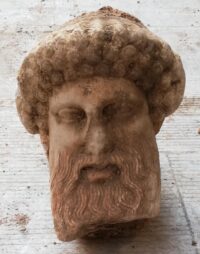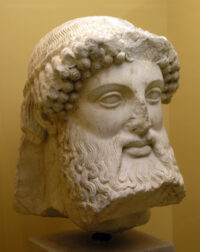 A marble bust of the Hermes, messenger of the gods, has been discovered during sewer construction in Athens, Greece. It is estimated to date from the end of the 4th century or early 3rd century B.C., when it was originally part of a herm, a rectangular pillar with a sculpted bust on top and genitalia at the base. Crews found the head on Friday, November 13th, built into the south wall of a modern drainage duct.
A marble bust of the Hermes, messenger of the gods, has been discovered during sewer construction in Athens, Greece. It is estimated to date from the end of the 4th century or early 3rd century B.C., when it was originally part of a herm, a rectangular pillar with a sculpted bust on top and genitalia at the base. Crews found the head on Friday, November 13th, built into the south wall of a modern drainage duct.
The newly-discovered bust is typical of the Hermes Propylaeus (Hermes of the Gateways) type created by ancient Greek sculptor Alcamenes in the mid-5th century B.C. and frequently copied throughout the Greco-Roman world. Alcamenes was known for blending elements of Archaic style from the 6th century B.C. with the greater expressive naturalism of Classical period. His Hermes couples the stylized curly hair and beard of an Archaic kore with  the differentiated facial features of the Classical. Also typical of the Archaic style, Hermes is depicted in mature age. His iconography would shift in the later Classical and Hellenistic periods to depictions of the deity as a lissome young man.
the differentiated facial features of the Classical. Also typical of the Archaic style, Hermes is depicted in mature age. His iconography would shift in the later Classical and Hellenistic periods to depictions of the deity as a lissome young man.
Because Hermes with his winged sandals was the god who protected travelers on their journeys, herms were erected at boundaries, crossroads, gateways and graves. This herm was originally a crossroads or gateway marker in Athens and was recycled for use in the sewer drains many centuries later.
The work is in good condition despite its checkered past, and is now in the care of the Ephorate of Antiquities.
———-
“Alkamenes’ Hermes couples the stylized curly hair and beard of an Archaic kore with the differentiated facial features of the Classical.”
———-
As far as I am concerned, ‘Kore’ is the girl, of which the male counterpart –bearded or not– would be the ‘Kyros’ dude.
Maybe, the “genitalia at the base” would give further hints :confused:
Typically a “kouros” in English.
Dr. E., not only in English: I was confused 🙁
Indeed, “Kouros” is correct, there is “Kore”, and –as I just looked it up– at least in Greek there would also be “Koure” as a female form, but probably not in marble.
In other words:
κόρη = girl
κούρη = young girl, daughter
κοῦρος = son
…not to be confused with
κῦρος = power
I just did a Google search for images of “herm” statues and had a good laugh!
I dimly remember from schoolboy days that Hermes statues were the root of a lot of troubles for Alcibiades
History of the Peloponnesian War, Bk.6, 26-29: …ὅσοι Ἑρμαῖ ἦσαν λίθινοι ἐν τῇ πόλει τῇ Ἀθηναίων […] μιᾷ νυκτὶ οἱ πλεῖστοι περιεκόπησαν τὰ πρόσωπα.
At the center of the accusation was Alkibiades, who, due to his lifestyle and his success in many situations, was exposed to constant attacks. The “mutilation of the Hermai” was used by opponents of Alkibiades as pretext to accuse him of the intention of a tyranny.
According to Thukydides, however, his opponents themselves planned to take over power. The plan was successful, and the opponents were thus able to use the mutilation of the Hermai and the desecration of the Eleusinian Mysteries against Alkibiades in absentia, i.e. while campaigning in Sicily.
Our “A level” class wrote essays discussing the motives of Alcibiades. I was the only one to go against the grain and write in his defence. I got 15 out of 20. The best essay scored 16 out of 20.
Our teacher showed the winning essay to a 1st year Durham University student he was tutoring. He told me he wouldn’t show the student my essay because it was “too confusing.” He didn’t question my facts, but just disagreed with my conclusions!